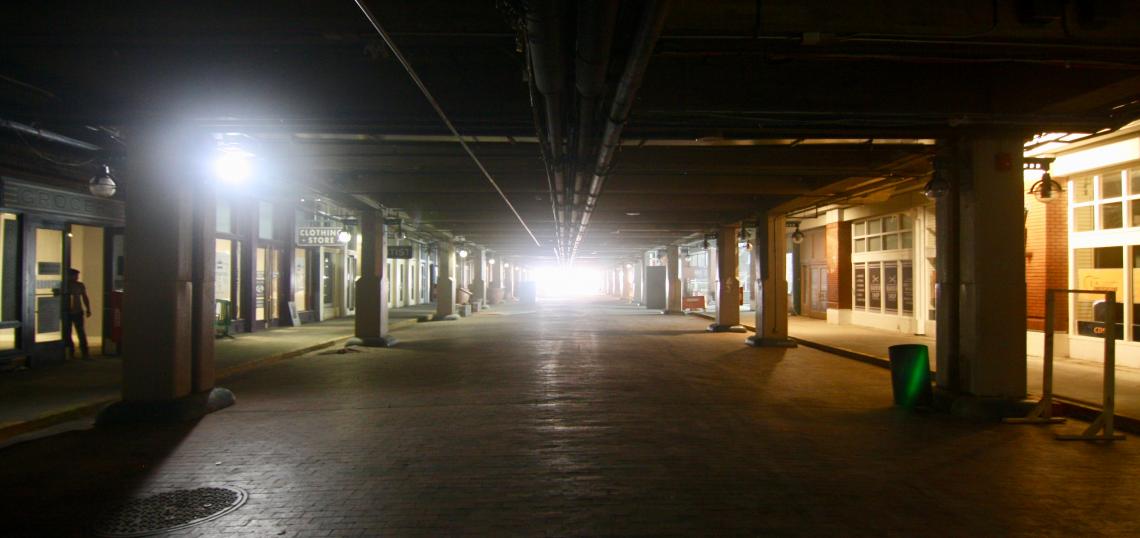A one-star Tripadvisor review from 2019 titled “Sketchy area” could summarize the general public’s opinion of Underground Atlanta in recent years.
“I had friends visiting from out of town who wanted to take in some of the sights downtown,” wrote the local reviewer. “We were nervous… I wouldn’t want to be here when the sun goes down.”
Another visitor from Brazil titled their 2018 review simply, “Broke my heart.”
But walk around the historic four-block property today, and several indicators—the ubiquitous crunch and boom from demolition crews removing concrete, the fresh storefronts and occupied offices, the optimism in people’s voices—lend a feeling that Underground could finally, truly be starting to change.
“That seems to be everyone’s question: ‘Is it really happening?’” says Underground’s creative director, Kris Pilcher, an artist and longtime downtown advocate hired by the property’s new ownership in March. “Yeah, it’s really happening.”
The skepticism is understandable. Promises of an Underground comeback—like grander ideas for transforming it into a casino—have been bandied about since its slow death began a generation ago. South Carolina-based shopping center developer WRS scooped up the 12-acre property from the city for $35 million in 2017—and proceeded to do little but fully close it, fence it off, and periodically release flashy renderings and grand proclamations.
In a city more concerned with the BeltLine’s impact and a promised rebirth of the nearby Gulch, the downtown icon devolved into an afterthought.
That changed suddenly in November, when the 30-something CEO of what’s now called Lalani Ventures, Shaneel Lalani, bought the stalled redevelopment site from WRS for $31 million, and within a few months was hosting charettes at Underground with heavyweight design and architecture firms. A.J. Robinson, Central Atlanta Progress president and a vocal downtown booster, came away from those meetings “inspired by the conversations and initial plans… and the team’s understanding of what’s needed to create a great place,” as Robinson said in April.
Since then, the Underground team has begun construction on a 21-stall food hall curated by Robert Montwaid, best known for creating New York’s Gansevoort Market. Two new businesses have opened, alongside music venue the Masquerade and a nightclub. And a gallery and coworking space has set up shop across three floors of 86 Pryor Street, a gorgeous brick building that could help demarcate where Underground’s two zones—one focused on retail, the other on arts—begin and end.
Pilcher, who keeps an office on the fourth floor of that building, says 40 artists so far are working alongside him daily. Lalani, the owner, rides MARTA in from his Decatur home each day, too, when he’s not arriving on an e-scooter, Pilcher says. That onsite experience has proven inspirational for what Pilcher hopes will become Underground’s multiphase resurgence into a 24-hour destination, where food, arts, culture, and commerce once again meet.
“What I’ve seen is just this resurgence of creativity and life across the property,” Pilcher says. “Last Saturday, there were a few thousand people walking back and forth, for the Atlanta United game, and the Masquerade had a big event, and the [biweekly] art carts program was happening here. We had bistro tables, and people were relaxing. There was really some public engagement that hasn’t happened around here in a long time.”
Underground leaders hope lasting momentum will start with the food hall, which could help replace numerous downtown food options felled by the COVID-19 pandemic.
In an email to Urbanize Atlanta, Lalani said Underground is in its “blank canvas” phase, during which the “great historic bones” and character are being embraced. He offered this forecast for the short and long term:
“Over the next year, we’ll create an immersive art hub with activated public spaces that invite the community to explore Underground, while we simultaneously work to revitalize the property for long-term success,” Lalani wrote. “In five years, Underground will feature best-in-class dining, shopping, and artful entertainment, creative office space, and new residential options. Our intent is for Underground to not only be the driving force in this new chapter of downtown’s story, but the defining piece.”
Tim Keane, Atlanta’s planning commissioner, applauds Lalani and company’s push for revitalization and density, but he cautioned that the initial phase of changes is crucial.
“It’s important that the first things that happen at Underground be seen as exemplifying what your standards are,” Keane said. “If you do something mediocre out of the gate, you’re in trouble, because it’s going to really dampen the potential. So I think they’re being patient and thinking through what they’re going to do first.”
For now, an Underground student housing and residential component are in permitting phases, and a Banksy art exhibit will debut in early September. Underground is also offering hourlong public tours the first Saturday of each month through the end of 2021, with proceeds benefitting Atlanta Mission.
In the meantime, head to the gallery for a deep dive around some of Atlanta’s oldest streets—once called “a city beneath the city”—for what could be a glimpse at Underground's “before” version.
• Recent downtown news, discussion (Urbanize Atlanta)







